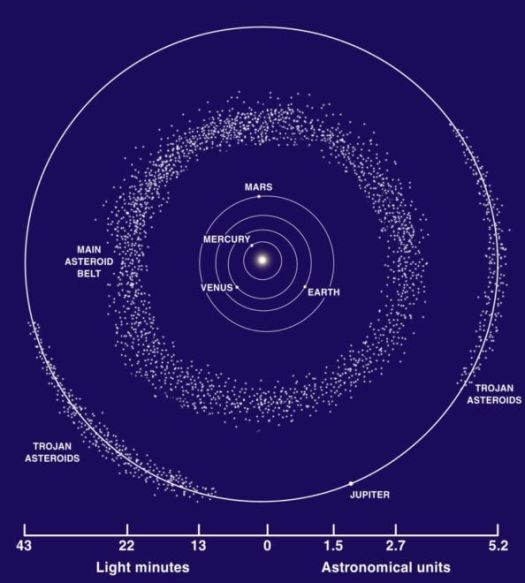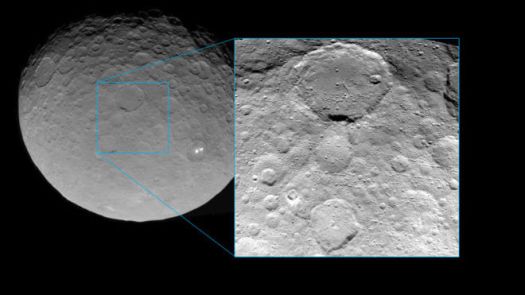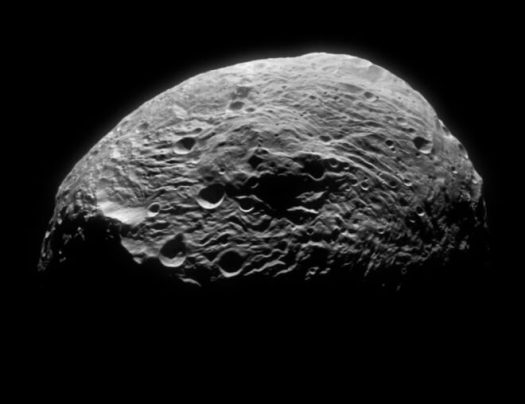
For most of us, asteroids exist primarily as a threat. An asteroid that landed around the Yucatan peninsula, after all, is generally considered to have set into motion the changes that resulted in the elimination of the dinosaurs.
Other large in-coming asteroids laid waste to swaths of Siberia in 1908, dug the world’s largest crater (118 mile wide) in South Africa long ago, and formed the Chesapeake Bay a mere 35 million years past. And another large asteroid will almost certainly threaten Earth again some day.
There is, however, a reverse and possibly life-enhancing side to the asteroid story, one that is becoming more clear and intriguing as we learn more about them where they live. Asteroids not only contain a lot of water — some of it possibly delivered long ago to a dry Earth — but they contain some pretty complex organic molecules, the building blocks of life.
The latest chapter in the asteroid saga is being written about Ceres, the largest asteroid in the solar system and recently declared to also be a dwarf planet (like Pluto.)
Using data from NASA’s Dawn spacecraft, a team led by the National Institute for Astrophysics in Rome and the University of California, Los Angeles identified a variety of complex organic compounds, amino acids and nucleobases — the kind that are the building blocks of life. The mission has also detected signs of a possible subsurface ocean as well as cryovolcanos, which spit out ice, water, methane and other gases instead of molten rock.
“This discovery of a locally high concentration of organics is intriguing, with broad implications for the astrobiology community,” said Simone Marchi, a senior research scientist at Southwest Research Institute and one of the authors of the paper in Science. “Ceres has evidence of ammonia-bearing hydrated minerals, water ice, carbonates, salts, and now organic materials.”
He said that the organic-rich areas include carbonates and ammonia-based minerals, which are Ceres’ primary constituents. Their presence along with the organics makes it unlikely that the organics arrived via another asteroid.
In an accompanying comment in the Feb. 16 edition of Science, Michael Küppers of the European Space Astronomy Center in Madrid makes the case that Ceres might once have even been habitable.
The paper provides “the first observations of organic material on Ceres, confirming the presence of such material in the asteroid belt,” he writes. “Furthermore, because Ceres is a dwarf planet that may still preserve internal heat from its formation period and may even contain a subsurface ocean.”

Asteroids are as ancient as the solar system, some 4.6 billion years old. They are the leftovers from the planet formation process that took place in the disk around the very early sun — pieces of rock that didn’t become parts of planets or moons and weren’t otherwise smashed to bits.
Both their ages and their compositions have made asteroids increasingly interesting to space scientists studying how the solar system came to look and behave as it does. The result has been a suite of missions to asteroids organized by NASA, the Japanese Aerospace Exploration Agency (JAXA), the European Space Agency, the Russian space agency Roskosmos, and the China National Space Administration.
Many of the missions include substantial collaboration between different national space agencies. The Dawn effort, for instance, has major European involvement. NASA’s OSIRIS-REx mission to the asteroid Bennu and the Japanese Hayabusa2 mission to Ryugu each have three co-investigators from the other agency — a first and an advance from NASA’s more traditional participating scientist program. Both spacecraft are now on their way, will spend months on their destination asteroids, and are designed to bring home samples (in 2020 for Hayabusa2 and 2023 for OSIRIS-REx.)
NASA also approved two additional asteroid missions earlier this year. The first mission, called Lucy, will study asteroids, known as Trojan asteroids, trapped by Jupiter’s gravity. The Psyche mission will explore a very large and rare object in the solar system’s asteroid belt — an asteroid made of metal. Scientists believe it might be the exposed core of a planet that lost its rocky outer layers from a series of violent collisions. Lucy is targeted for launch in 2021 and Psyche in 2023.
Why so many asteroid missions?
I put the question to Harold C. Connolly Jr. of Rowan University, mission sample scientist for OSIRIS-REx and a co-investigator for the mission. He answered by email from Japan, together with Shogo Tachibana of Hokkaido University, who is a principal investigator of the sampling device and the sample analysis of Hayabusa2. Both are co- investigators for the others’ sample analysis efforts.
“The science is really driving the interest,” they wrote. “There now exists broader understanding that asteroids are time capsules to the past and can help illuminate the origin of Earth-like planets and potentially even the materials and conditions that lead to the origin of life.
“The target asteroids of both missions are a treasure box of the earliest time period of the solar system, with such riches as prebiotic compounds (precursors to life-building organics) preserved in them.”
In Japan, the Hayabusa2 mission is also a follow-on to the hugely popular original Hayabusa mission, which returned with grains from the asteroid Itokawa in 2010. Despite enormous difficulties and the failure of its lander, the spacecraft brought back enough sample to tell scientists that the asteroid was four billion years old, at one time was exposed to temperatures of 800 degrees centigrade, and much more.
Hayabusa inspired so much interest in Japan that it led to not only the follow-on mission but also three movies, including one with star actor Ken Watanabe.

In a phone conversation, Küppers of the European Space Astronomy Center expanded on the scientific importance of asteroids.
He said that Ceres research has already determined that asteroid most likely was formed further out in the solar system and then migrated in. This conclusion flows from the observed presence of geological features and minerals on the surface that require the presence of water to form. Closer-in asteroids are believed to have had any water baked out of them, strongly suggesting that Ceres was once further from the sun.
That asteroidal (and cometary) water plays an important role in the history of Earth. “The oceans on Earth certainly could have been filled with water, and organic compounds, from asteroids like Ceres,” Küppers said. Different kinds of water have different isotopic signatures, and the water signature on Earth is very much like that detected in some asteroids and comets.
The Dawn spacecraft has already visited the large asteroid Vesta on its mission, and found minerals formed in water, a geology with steep cliffs and landslides, and the presence of an enormous crater at one of the poles. For Vesta, as for Ceres, a primary goal of the Dawn mission was to map the asteroid in various ways and with substantial precision. The overall goal, however, is to explore the conditions and processes found on worlds as old as the solar system.
While Vesta is a described as a “protoplanet” because of its size, Ceres is considered to be a dwarf planet (as well as an asteroid) because it has sufficient mass and gravity to be rounded like a planet. Vesta, and the other asteroids, are not. Itokawa, below, is considerably smaller than Ceres or Vesta, and so has been rounded far less.



What was planned to be the biggest NASA asteroid mission is the Asteroid Redirect Mission. It was proposed as the first robotic mission to visit a large near-Earth asteroid, to collect a multi-ton boulder from its surface, and to then redirect it into a stable orbit around the moon. Once in orbit around the moon, astronauts would explore it and return with samples in the 2020s.
The proposed mission was driven by science, but also was part of NASA’s plan to advance the new technologies and spaceflight experience needed for a human mission to the Martian system in the 2030s. What’s more, some space scientists are concerned about the possibility of a large asteroid heading our way, and they want to develop techniques for just slightly changing an in-coming asteroid’s path so it would miss Earth.
Many in Congress were never excited by the asteroid re-direct plan, and the future of the mission remains quite uncertain.
But the part of the mission involved with learning more about asteroid pathways and how they might be changed is still, at least indirectly, alive.
That’s because the asteroid Bennu, the destination for OSIRIS-REx, is one that often comes close to the Earth. (The acronym, by the way, stands for the Origins Spectral Interpretation Resource Identification Security Regolith Explorer.)
As explained on the NASA OSIRIS-REx webside, “Bennu is a B-type asteroid with a ~500 meter diameter. It completes an orbit around the sun every 436.604 days (1.2 years) and every 6 years comes very close to Earth, within 0.002 astronomical units (the term used to describe the distance from the sun to Earth.) These close encounters give Bennu a high probability of impacting Earth in the late 22nd century.”
Some put that probability of an Earth impact considerably lower, but it is nonetheless a sobering thought given the destruction that asteroids have periodically inflicted on the planet.
